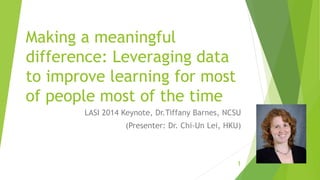Tiffany Barnes "Making a meaningful difference: Leveraging data to improve learning for most of people most of the time"
- 1. Making a meaningful difference: Leveraging data to improve learning for most of people most of the time LASI 2014 Keynote, Dr.Tiffany Barnes, NCSU (Presenter: Dr. Chi-Un Lei, HKU) 1
- 2. Outline The Future of Learning Getting there Case Study: Intelligent tutoring system (2009-2013) Skipped technical discussions Guiding Principles 2
- 3. The Future of Learning Recognizing and promoting excellence in teaching and learning Non-intrusive model to recognize mastery, commitment, engagement, mentoring and teaching potential in learners Combined with detectors that recognize student needs Real time support for effective culture Identified when/where potential collaborators are working on similar tasks and pairs them according to maximum likelihood of a beneficial peer learning relationship Hints on how the interaction can be most helpful
- 4. The Future of Learning Blurring the boundary between teachers and learners Learner promoted to become tutors and content creators Knowledge modeling to constantly maintain flow during learning while detecting the needs of learning 4
- 5. Getting There Achievements Knowledge models portable, sharable, transparent to students Integrate with learning systems like those with games Detectors constantly updating achievements Diverse learning environments Forum, wikis, labs, assessments, tutorials, readings EDM models informed from all
- 6. Getting There Relationships Detecting features that predict effective teacher/learner or peer tutor/mentee relationships Providing scaffolds to continually support these Focused around learning activities of current interest to users But allowing for off-task activities that strengthen relationships and recognize that learners and teachers are people 6
- 7. Case Study CAREER: Educational Data Mining for Student Support in Interactive Learning Environments NSF-IIS (2009-2013) Intelligent tutoring system Use student data to construct models that represent student solutions Trace student behavior in the model Provide feedback and hints based on past records from students 7
- 8. Technical Methodology Data-derived model tracer Graph answer of students Calculate transition probabilities Reward good solutions and penalize errors What does this give us? Likely paths students take A value for each state - This value is important Use to provide help in the form of hints 8
- 9. What types of tutors? General: Problem solving Maths. (Algebra, Geometry, Logic, Induction) Science (Chemistry and Physics) Language and reading Field test: Over 200 students per year Discrete Math Logic and Algorithms Students have difficulty developing strategies to solve proofs 9
- 10. 10
- 11. 11
- 12. How to Generate a Hint Sequence To generate hints Suggest the next state with the highest value Generate hints from the state features of that state To create a hint sequence Indicate a goal expression to derive Indicate the statements that should be used Indicate the rule to apply next 12
- 13. How Often Will a Hint Be Available? Experiment of four semesters of past data 523 valid student attempts 381 (73%) were complete, 142 (27%) were partially complete Over all steps, hints only available for 45% of moves However, 90% of Hint Requests were successful More problems were completed with hints 13
- 14. 14
- 15. How to Determinate Master Learning? Assume that students who complete a system have mastered it Break down the system data into intervals Model learning at the end of each interval Compare new students to exemplar model to determine mastery 15
- 16. 16
- 17. Guiding Principles Respect Personalized models and adaptive contents “People can offer to the learning environment and to one another” Beneficence Look for practical effect sizes Move towards standardized data models and methods Maximize potential of research to result in positive changes in educational systems Justice Consider equality in developing and deploying systems Many ways to demonstrate (and measure) proficiency/mastery

















